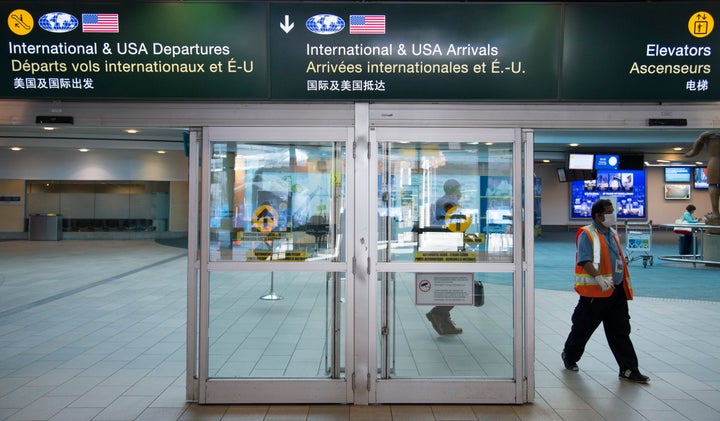
OTTAWA — The federal government is warning Canadians abroad who aren’t able to get home that they may be forced to hunker down for a while.
There is no massive worldwide repatriation effort — the type seen during the Wuhan evacuation — planned for the tens of thousands of Canadians struggling to return to Canada, HuffPost Canada has learned.
Instead, officials are hoping to work with countries that have already shut down their airspace and land borders and persuade them to let commercial flights land and a large concentration of stressed Canadian tourists depart.
Prime Minister Justin Trudeau on Friday announced the first flight will leave this weekend to pick up passengers in Morocco.
“We are doing everything we can to help,” Foreign Affairs Minister François-Philippe Champagne’s spokesman, Adam Austin, told HuffPost.
The situation is changing daily and rapidly, he said, leaving officials scrambling to deal with a historic and unprecedented situation.
Watch: Social distancing measures could last weeks, months: PM
“In some cases, measures taken [locally] have led to the complete cancellation of flights. These instances could well mean that some Canadians will not be able to return home for an indeterminate period of time,” Austin said.
“If this is the case, we strongly recommend that you follow the advice of local authorities regarding health and safety.”
There are approximately 400,000 Canadians abroad registered with the federal government, though an estimated three million are thought to be living, working and travelling outside Canada at any given time.
In Peru, where the government declared a state of emergency Sunday evening and imposed a mandatory 15-day quarantine, authorities gave tourists until midnight Monday before shutting down all international borders. More than 4,300 Canadians are registered with the Canadian embassy in Lima.
Nicole Bayes-Fleming and her boyfriend, Luke Carroll, were touring the Peruvian countryside as part of a four-months-long backpacking trip throughout South America, when they heard the border was closing. They caught a midnight bus back to Lima on Monday, hoping to secure a spot on a last-minute flight. They spent nine hours at the airport trying to piece together information from social media and news reports but were unable to get home.

“Everything happened so fast. It was just mass confusion,” said Bayes-Fleming, a 24-year-old Toronto resident.
Despite being registered with the Canadian embassy, she said, they received little information from the Canadian government. Ten hours after the state of emergency was declared, she received a generic email advising her to book a commercial flight.
“It’s reprehensible that the government expects us to navigate all of this, to understand the intricacies of foreign policy and border control when we’re just two 20-somethings who came out here backpacking months and months ago,” she said.
“People are saying the government is doing everything it can right now. I personally disagree.”
Bayes-Fleming said she knows of tourists from the United States, Mexico and Israel who were able to get flights home. “It raíses questions about why Canada wasn’t able to do that as well.”
In the Philippines, where the government has imposed a month-long lockdown and cancelled all domestic and international flights until April 14, former Montrealer Steven Young wrote to HuffPost pleading for help.
“I’m stuck in the Philippines where all public transportation is shut down meaning that there is no way to get to the airport to leave. The government will shut down the airport in 36h. The embassy in Manila is unreachable,” he said in a message over Facebook.
’If I go back to Canada, where would I go?′
Young’s hotel closed down, forcing him to find more expensive accommodation, he said, and now, the English teacher who has been working in China for almost four years, worries that he’s in limbo.
“If I go back to Canada, where would I go?” he asked. “Going back to China at this time is impractical, since there are heavy restrictions in place.”
“I’ll be stuck here until mid-April unless the Manila/Philippines government backs down on some of the rules,” he added.
“Everything in Manila happened so quickly and I didn’t really have enough time to make a good decision.”
On Monday, Trudeau echoed remarks his ministers had made days earlier urging Canadians to avoid non-essential travel outside the country. He said travellers should “return to Canada via commercial means while it is still possible to do so.”
That advisory — to avoid non-essential travel outside Canada — remains on the federal government’s website and has not been upgraded to the toughest message: “Avoid all travel.”
Ottawa notes that the situation abroad is volatile.
“To limit the spread of COVID-19,” Global Affairs Canada states, “many countries have put in place travel or border restrictions and other measures such as movement restrictions and quarantines. Airlines have cancelled flights. New restrictions may be imposed with little warning. Your travel plans may be severely disrupted and you may be forced to remain outside of Canada longer than expected.”
The United States on Thursday upgraded its travel advisory to: “Do not travel.”
“If you choose to travel internationally … you may be forced to remain outside of the United States for an indefinite timeframe,” the State Department warns.
The U.S. government also notes that some of its embassy personnel have been authorized to depart — much like in Canada — and this may limit the ability of the federal government to assist with consular services.
On Tuesday, Trudeau told Canadians that Ottawa is looking at “every possible way of bringing Canadians home” but suggested that there are just too many of them to bring back.
“I think it is just realistic to know that there are some of them who will not be coming home in the coming weeks,” Trudeau said.
The government, he added, will ensure support is available, such as a $5,000 loan for those in need of temporary assistance.
“We are [also] looking at flights,” he said in French. “We are looking to see what we can do to facilitate the return of the greatest number of Canadians possible in the shortest possible delay.”

That day, in sharp contrast, Germany announced it is setting aside €50 million to repatriate its stranded tourists. Flights were planned for Morocco, the Dominican Republic, the Philippines, and the Maldives.
Tens of thousands of Canadian travellers are believed to be in need of assistance. In one day alone this week, Global Affairs Canada received more than 10,000 emails and 6,000 phone calls requesting help.
Wednesday evening, wireless carriers sent text messages to Canadians roaming abroad asking them to register with the government. Officials are hoping to gather a better picture of where the needs are and where large and vulnerable concentrations of tourists might be, in order to prioritize their efforts.
Speaking to Radio-Canada on Friday, Champagne said the government has to negotiate, country by country, access to airspace and landing rights. They must also ensure an open airport and that flight crews won’t be quarantined when they arrive. Canadians also have to be able to get to the airport — which isn’t always the case when public and private travel is banned and whole regions of countries are under lockdown.
“In a way, the easiest step is [securing] the plane,” he said.
In Peru, for example, the foreign minister noted the airspace is not only closed but so too is the airport in Lima, and there are restrictions on interprovincial travel.
What adds to more complications, Champagne said, is that airlines are reducing their capacity, alluding to the 5,000 job losses at Air Canada Friday.
For Bayes-Fleming and Carroll, who are now hunkered down in an apartment conveniently located next to a grocery store, time ticks slowly by. They may be there for weeks, perhaps even months. Quarantine means they aren’t allowed to go outside except for essential items, and there is a nightly 8 p.m. curfew.
“Peru is completely shut down,” Bayes-Fleming said. “The vibe is very strange. Every night when the sun goes down, people start applauding on their patios.”
‘It is scary to not know what’s next’
The pair managed to book seats on an Air Canada flight two weeks from now for $900 each, but as she watches airlines cancel flights around the world, Bayes-Fleming isn’t confident she’s coming home.
“It is scary to not know what’s next, how long will this go on? A couple of weeks or months? How long can we afford it?” she said.
The two haven’t received any information about the federal government’s financial assistance loan. On Thursday, Bayes-Fleming received an email asking her to fill out a form if she wanted to be considered for a return flight to Canada. It asked whether she is over 65 years old or under 18 years old, has a medical condition, or requires special assistance on a flight.
“We underline that we do not have specific flight options organized,” the email stated.
With files from Rebecca Zamon